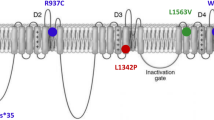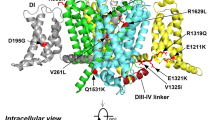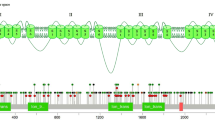Abstract
Dravet syndrome (DS) is a rare and severe epileptic syndrome of childhood with prevalence between 1/22,000 and 1/49,900 of live births. Approximately 80% of patients with this syndrome present SCN1A pathogenic variants, which encodes an alpha subunit of a neural voltage-dependent sodium channel. There is a correlation between PCDH19 pathogenic variants, encodes the protocadherin 19, and a similar disease to DS known as DS-like phenotype. The present review aims to clarify the differences between DS and DS-like phenotype according to the SCN1A and PCDH19 variants. A systematic review was conducted in PubMed and Virtual Health Library (VHL) databases, using “Dravet Syndrome” and “Severe Myoclonic Epilepsy in Infancy (SMEI)” search words, selecting cohort of studies published in journal with impact factor of two or greater. The systematic review was according to the Preferred Reporting Items for Systematic Review and Meta-Analysis recommendations. Nineteen studies were included in the present review, and a significant proportion of patients with DS-carrying SCN1A was greater than patients with DS-like phenotype-harboring PCDH19 variants (76.6% versus 23.4%). When clinical and genetic data were correlated, autism was predominantly observed in patients with DS-like-carrying PCDH19 variants compared to SCN1A variant carriers (62.5% versus 37.5%, respectively, P-value = 0.044, P-value corrected = 0.198). In addition, it was noticed a significant predisposition to hyperthermia during epilepsy crisis in individuals carrying PCDH19 variants (P-value = 0.003; P-value corrected = 0.027). The present review is the first to point out differences between the DS and DS-like phenotype according to the SCN1A and PCDH19 variants.

Similar content being viewed by others
Data availability
All data generated or analyzed during this study are included in this published article (and its Supplementary Information files).
References
Scheffer IE (2012) Diagnosis and long-term course of Dravet syndrome. Eur J Paediatr Neurol 16:S5. https://doi.org/10.1016/j.ejpn.2012.04.007
League I, Epilepsy A (1985) Proposal for classification of epilepsies and epileptic syndromes. Epilepsia 26:268–278. https://doi.org/10.1111/j.1528-1157.1985.tb05417.x
Wu YW, Sullivan J, McDaniel SS, Meisler MH, Walsh EM, Li SX et al (2015) Incidence of dravet syndrome in a US population. Pediatrics 136:e1310–e1315. https://doi.org/10.1542/peds.2015-1807
Bayat A, Hjalgrim H, Møller RS (2015) The incidence of SCN1A-related Dravet syndrome in Denmark is 1:22,000: a population-based study from 2004 to 2009. Epilepsia 56:e36–e39. https://doi.org/10.1111/epi.12927
Fountain-Capal JK, Holland KD, Gilbert DL, Hallinan BE (2011) When should clinicians order genetic testing for dravet syndrome? Pediatr Neurol 45:319–323. https://doi.org/10.1016/j.pediatrneurol.2011.08.001
Higurashi N, Shi X, Yasumoto S, Oguni H, Sakauchi M, Itomi K et al (2012) PCDH19 mutation in Japanese females with epilepsy. Epilepsy Res 99:28–37. https://doi.org/10.1016/j.eplepsyres.2011.10.014
Chemaly N, Losito E, Pinard JM, Gautier A, Villeneuve N, Arbues AS et al (2018) Early and long-term electroclinical features of patients with epilepsy and PCDH19 mutation. Epileptic Disord 20:457–467. https://doi.org/10.1684/epd.2018.1009
Trivisano M, Pietrafusa N, di Ciommo V, Cappelletti S, de Palma L, Terracciano A et al (2016) PCDH19-related epilepsy and Dravet syndrome: face-off between two early-onset epilepsies with fever sensitivity. Epilepsy Res 125:32–36. https://doi.org/10.1016/j.eplepsyres.2016.05.015
Kwong AKY, Fung CW, Chan SY, Wong VCN (2012) Identification of SCN1A and PCDH19 mutations in Chinese children with Dravet syndrome. PLoS One 7. https://doi.org/10.1371/journal.pone.0041802
de Lange IM, Koudjis MJ, van’t Slot R, Gunning B, Sonsma ACM, van Gemert LJJM et al (2018) Mosaicism of de novo pathogenic SCN1A variants in epilepsy is a frequent phenomenon that correlates with variable phenotypes. Epilepsia 59:690–703. https://doi.org/10.1111/epi.14021
Esterhuizen AI (2019) Dravet syndrome in South African infants: tools for an early diagnosis. Seizure 176:139–148. https://doi.org/10.1016/j.seizure.2018.09.010.DRAVET
Skjei KL, Church EW, Harding BN, Santi M, Holland-Bouley KD, Clancy RR et al (2015) Clinical and histopathological outcomes in patients with SCN1A mutations undergoing surgery for epilepsy. J Neurosurg Pediatr 16:668–674. https://doi.org/10.3171/2015.5.PEDS14551
Zucca C, Redaelli F, Epifanio R, Zanotta N, Romeo A, Lodi M et al (2008) Cryptogenic epileptic syndromes related to SCN1A twelve novel mutations identified. Arch Neurol 65(4):489–494. https://doi.org/10.1001/archneur.65.4.489
Moher D, Liberati A, Tetzlaff J, Altman DG, Altman D, Antes G, et al (2009) Preferred reporting items for systematic reviews and meta-analyses: the PRISMA statement. PLoS Med 6. https://doi.org/10.1371/journal.pmed.1000097.
Sampson J. Newcastle-Ottawa quality assessment scale case-control studies 2554:9
Shea B, Robertson J, Peterson J, Welch V, Losos M (2012) The Newcastle-Ottawa Scale (NOS) for assessing the quality of nonrandomized studies in meta- analysis bias and confounding Newcastle-Ottowa Scale. Available from: http://www.ohri.ca/programs/clinical_epidemiology/oxford.htm. Accessed 19 Jan 2020
de Lange IM, Gunning B, Sonsma ACM, van Gemert L, van Kempen M, Verbeek NE et al (2019) Outcomes and comorbidities of SCN1A-related seizure disorders. Epilepsy Behav 90:252–259. https://doi.org/10.1016/j.yebeh.2018.09.041
Snoeijen-Schouwenaars FM, Veendrick MJBM, Van Mierlo P, Van Erp G, De Louw AJA, Kleine BU et al (2015) Carbamazepine and oxcarbazepine in adult patients with Dravet syndrome: friend or foe? Seizure 29:114–118. https://doi.org/10.1016/j.seizure.2015.03.010
Till Á, Zima J, Fekete A, Bene J, Czakó M, Szabó A et al (2020) Mutation spectrum of the SCN1A gene in a Hungarian population with epilepsy. Seizure 74:8–13. https://doi.org/10.1016/j.seizure.2019.10.019
Nicita F, Spalice A, Papetti L, Nikanorova M, Iannetti P, Parisi P (2014) Efficacy of verapamil as an adjunctive treatment in children with drug-resistant epilepsy: a pilot study. Seizure 23:36–40. https://doi.org/10.1016/j.seizure.2013.09.009
Verbeek NE, van der Maas NAT, Jansen FE, van Kempen MJA, Lindhout D, Brilstra EH (2013) Prevalence of SCN1A-related Dravet syndrome among children reported with seizures following vaccination: a population-based ten-year cohort study. PLoS One 8. https://doi.org/10.1371/journal.pone.0065758
Damiano JA, Deng L, Li W, Burgess R, Schneider AL, Crawford NW et al (2020) SCN1A variants in vaccine-related febrile seizures: a prospective study. Ann Neurol 87:281–288. https://doi.org/10.1002/ana.25650
Cetica V, Chiari S, Mei D, Parrini E, Grisotto L, Marini C et al (2017) Clinical and genetic factors predicting Dravet syndrome in infants with SCN1A mutations. Neurology 88(11):1037–1044. https://doi.org/10.1212/WNL.0000000000003716
Hattori J, Ouchida M, Ono J, Miyake S, Maniwa S, Mimaki N et al (2008) A screening test for the prediction of Dravet syndrome before one year of age. Epilepsia 49:626–633. https://doi.org/10.1111/j.1528-1167.2007.01475.x
Afawi Z, Oliver K, Kivity S, Mazarib A, Blatt L, Neufeld M, et al (2016) Multiplex families with epilepsy success of clinical and molecular genetic characterization Supplemental data at Neurology.org
Wang J, Wen Y, Zhang Q, Yu S, Chen Y, Wu X et al (2019) Gene mutational analysis in a cohort of Chinese children with unexplained epilepsy: identification of a new KCND3 phenotype and novel genes causing Dravet syndrome. Seizure 66:26–30. https://doi.org/10.1016/j.seizure.2019.01.025
Naslavsky MS, Yamamoto GL, de Almeida TF, Ezquina SAM, Sunaga DY, Pho N et al (2017) Exomic variants of an elderly cohort of Brazilians in the ABraOM database. Hum Mutat 38:751–763. https://doi.org/10.1002/humu.23220
Feenstra B, Pasternak B, Geller F, Carstensen L, Wang T, Huang F et al (2014) Common variants associated with general and MMR vaccine-related febrile seizures. Nat Genet 46:1274–1282. https://doi.org/10.1038/ng.3129
Author information
Authors and Affiliations
Contributions
A.C.M.R. and R.R.P.S. collected data and wrote the manuscript. F.A.M. collected data. R.F.S. reviewed clinical data. F.A.L.M. did statistical analysis. M.M.O. and P.H.P.A. guided the study and reviewed the manuscript.
Corresponding author
Ethics declarations
Ethics approval and consent to participate
Not applicable.
Consent for publication
Not applicable.
Conflict of interest
The authors declare no competing interest.
Additional information
Publisher's note
Springer Nature remains neutral with regard to jurisdictional claims in published maps and institutional affiliations.
Rights and permissions
About this article
Cite this article
Rampazzo, A.C.M., dos Santos, R.R.P., Maluf, F.A. et al. Dravet syndrome and Dravet syndrome-like phenotype: a systematic review of the SCN1A and PCDH19 variants. Neurogenetics 22, 105–115 (2021). https://doi.org/10.1007/s10048-021-00644-7
Received:
Accepted:
Published:
Issue Date:
DOI: https://doi.org/10.1007/s10048-021-00644-7




